CAT Exam > CAT Questions > Two round table sessions were held deliberati...
Start Learning for Free
Two round table sessions were held deliberating over the feasibility of the European Super League. 8 members A, B, C, D, E, F, G, H participated in both round table sessions. They might sit at the same or different places in the 2 sessions. Also, the following is known about the relative positions of the persons in the first session:
- G is not adjacent to B or E.
- F is not adjacent to A or C.
- B is not equidistant from A and C.
- B is 5 places to the right of E.
- All the people are facing the table.
- A is sitting diametrically opposite C.
Also, the following information is known about the relative positions of the persons in the second session, with respect to their positions in the first session:
- G is not adjacent to H.
- B and C must have one person between them, and that person is not H.
- A moves 3 places to his left.
- E and D moves to their diametrically opposite positions.
- Only H sits at the same place he was sitting in the first session.
- All people are facing the table.
Based on the information given above, answer the questions that follow.
Q. If E is sitting to the immediate left of G in the second session, who was sitting one seat to the left of A in the first session?
- a)H
- b)G
- c)B
- d)D
Correct answer is option 'A'. Can you explain this answer?
| FREE This question is part of | Download PDF Attempt this Test |
Verified Answer
Two round table sessions were held deliberating over the feasibility o...
First, we would try to determine the relative positions of A to H for the first session. We know in hint 5 that all the people are facing the table.
Using hint 6,
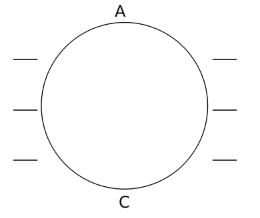
Using hint 4 and hint 3 together, we get the following 2 arrangements.
Using hint 6,

Using hint 4 and hint 3 together, we get the following 2 arrangements.
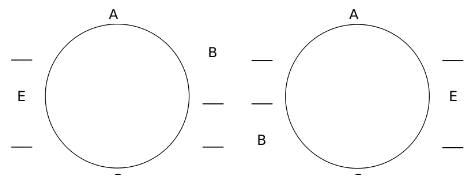
Using hint 2, we can add F to the arrangements as follows:
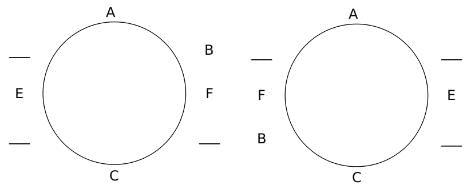
Using hint 1, we can add G to the arrangements as follows:
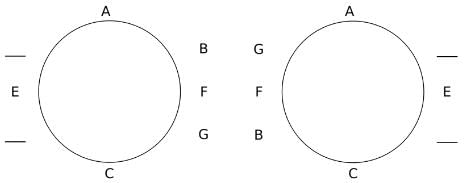
We are yet to figure out the positions of D and H. So let us consider all possible alternatives for their positions:

Now let us use the hints given to determine the positions in the second session. We know that they are facing the table.
Using hints 5 and 4 in all the four configurations, we get their arrangements in the second sessions as follows:
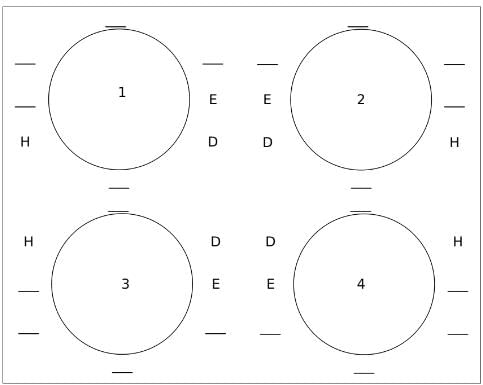
In the second session, A moves 3 places to his left, but in arrangements 1 and 2, that place is already occupied.
So, those are invalidated. We can process the remaining information on arrangements 3 and 4. Also, we can add this information (new position of A) in 3 and 4.
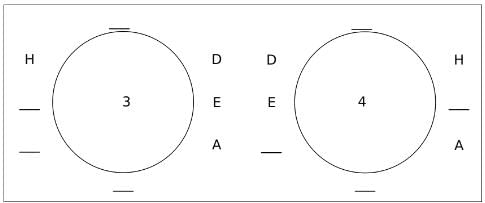
Using hint (2) and the fact that all people but H are in different seats, we get the following:
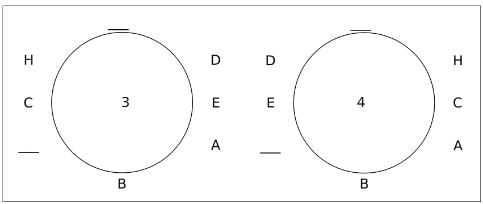
G is not adjacent to H.
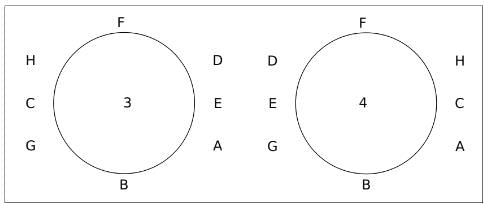
Therefore the 2 different possible seating arrangements in the first and second sessions are as follows:
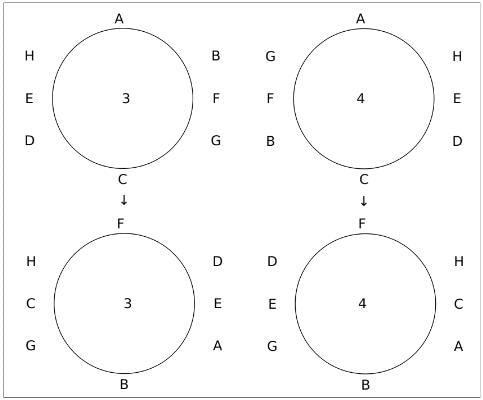
E is sitting to the immediate left of G in the second session, so it is the arrangement numbered 4. In the same arrangement, H was sitting one place to the left of A.

|
Explore Courses for CAT exam
|

|
Similar CAT Doubts
Two round table sessions were held deliberating over the feasibility of the European Super League. 8 members A, B, C, D, E, F, G, H participated in both round table sessions. They might sit at the same or different places in the 2 sessions. Also, the following is known about the relative positions of the persons in the first session: G is not adjacent to B or E. F is not adjacent to A or C. B is not equidistant from A and C. B is 5 places to the right of E. All the people are facing the table. A is sitting diametrically opposite C.Also, the following information is known about the relative positions of the persons in the second session, with respect to their positions in the first session: G is not adjacent to H. B and C must have one person between them, and that person is not H. A moves 3 places to his left. E and D moves to their diametrically opposite positions. Only H sits at the same place he was sitting in the first session. All people are facing the table.Based on the information given above, answer the questions that follow.Q.If E is sitting to the immediate left of G in the second session, who was sitting one seat to the left of A in the first session?a)Hb)Gc)Bd)DCorrect answer is option 'A'. Can you explain this answer?
Question Description
Two round table sessions were held deliberating over the feasibility of the European Super League. 8 members A, B, C, D, E, F, G, H participated in both round table sessions. They might sit at the same or different places in the 2 sessions. Also, the following is known about the relative positions of the persons in the first session: G is not adjacent to B or E. F is not adjacent to A or C. B is not equidistant from A and C. B is 5 places to the right of E. All the people are facing the table. A is sitting diametrically opposite C.Also, the following information is known about the relative positions of the persons in the second session, with respect to their positions in the first session: G is not adjacent to H. B and C must have one person between them, and that person is not H. A moves 3 places to his left. E and D moves to their diametrically opposite positions. Only H sits at the same place he was sitting in the first session. All people are facing the table.Based on the information given above, answer the questions that follow.Q.If E is sitting to the immediate left of G in the second session, who was sitting one seat to the left of A in the first session?a)Hb)Gc)Bd)DCorrect answer is option 'A'. Can you explain this answer? for CAT 2024 is part of CAT preparation. The Question and answers have been prepared according to the CAT exam syllabus. Information about Two round table sessions were held deliberating over the feasibility of the European Super League. 8 members A, B, C, D, E, F, G, H participated in both round table sessions. They might sit at the same or different places in the 2 sessions. Also, the following is known about the relative positions of the persons in the first session: G is not adjacent to B or E. F is not adjacent to A or C. B is not equidistant from A and C. B is 5 places to the right of E. All the people are facing the table. A is sitting diametrically opposite C.Also, the following information is known about the relative positions of the persons in the second session, with respect to their positions in the first session: G is not adjacent to H. B and C must have one person between them, and that person is not H. A moves 3 places to his left. E and D moves to their diametrically opposite positions. Only H sits at the same place he was sitting in the first session. All people are facing the table.Based on the information given above, answer the questions that follow.Q.If E is sitting to the immediate left of G in the second session, who was sitting one seat to the left of A in the first session?a)Hb)Gc)Bd)DCorrect answer is option 'A'. Can you explain this answer? covers all topics & solutions for CAT 2024 Exam. Find important definitions, questions, meanings, examples, exercises and tests below for Two round table sessions were held deliberating over the feasibility of the European Super League. 8 members A, B, C, D, E, F, G, H participated in both round table sessions. They might sit at the same or different places in the 2 sessions. Also, the following is known about the relative positions of the persons in the first session: G is not adjacent to B or E. F is not adjacent to A or C. B is not equidistant from A and C. B is 5 places to the right of E. All the people are facing the table. A is sitting diametrically opposite C.Also, the following information is known about the relative positions of the persons in the second session, with respect to their positions in the first session: G is not adjacent to H. B and C must have one person between them, and that person is not H. A moves 3 places to his left. E and D moves to their diametrically opposite positions. Only H sits at the same place he was sitting in the first session. All people are facing the table.Based on the information given above, answer the questions that follow.Q.If E is sitting to the immediate left of G in the second session, who was sitting one seat to the left of A in the first session?a)Hb)Gc)Bd)DCorrect answer is option 'A'. Can you explain this answer?.
Two round table sessions were held deliberating over the feasibility of the European Super League. 8 members A, B, C, D, E, F, G, H participated in both round table sessions. They might sit at the same or different places in the 2 sessions. Also, the following is known about the relative positions of the persons in the first session: G is not adjacent to B or E. F is not adjacent to A or C. B is not equidistant from A and C. B is 5 places to the right of E. All the people are facing the table. A is sitting diametrically opposite C.Also, the following information is known about the relative positions of the persons in the second session, with respect to their positions in the first session: G is not adjacent to H. B and C must have one person between them, and that person is not H. A moves 3 places to his left. E and D moves to their diametrically opposite positions. Only H sits at the same place he was sitting in the first session. All people are facing the table.Based on the information given above, answer the questions that follow.Q.If E is sitting to the immediate left of G in the second session, who was sitting one seat to the left of A in the first session?a)Hb)Gc)Bd)DCorrect answer is option 'A'. Can you explain this answer? for CAT 2024 is part of CAT preparation. The Question and answers have been prepared according to the CAT exam syllabus. Information about Two round table sessions were held deliberating over the feasibility of the European Super League. 8 members A, B, C, D, E, F, G, H participated in both round table sessions. They might sit at the same or different places in the 2 sessions. Also, the following is known about the relative positions of the persons in the first session: G is not adjacent to B or E. F is not adjacent to A or C. B is not equidistant from A and C. B is 5 places to the right of E. All the people are facing the table. A is sitting diametrically opposite C.Also, the following information is known about the relative positions of the persons in the second session, with respect to their positions in the first session: G is not adjacent to H. B and C must have one person between them, and that person is not H. A moves 3 places to his left. E and D moves to their diametrically opposite positions. Only H sits at the same place he was sitting in the first session. All people are facing the table.Based on the information given above, answer the questions that follow.Q.If E is sitting to the immediate left of G in the second session, who was sitting one seat to the left of A in the first session?a)Hb)Gc)Bd)DCorrect answer is option 'A'. Can you explain this answer? covers all topics & solutions for CAT 2024 Exam. Find important definitions, questions, meanings, examples, exercises and tests below for Two round table sessions were held deliberating over the feasibility of the European Super League. 8 members A, B, C, D, E, F, G, H participated in both round table sessions. They might sit at the same or different places in the 2 sessions. Also, the following is known about the relative positions of the persons in the first session: G is not adjacent to B or E. F is not adjacent to A or C. B is not equidistant from A and C. B is 5 places to the right of E. All the people are facing the table. A is sitting diametrically opposite C.Also, the following information is known about the relative positions of the persons in the second session, with respect to their positions in the first session: G is not adjacent to H. B and C must have one person between them, and that person is not H. A moves 3 places to his left. E and D moves to their diametrically opposite positions. Only H sits at the same place he was sitting in the first session. All people are facing the table.Based on the information given above, answer the questions that follow.Q.If E is sitting to the immediate left of G in the second session, who was sitting one seat to the left of A in the first session?a)Hb)Gc)Bd)DCorrect answer is option 'A'. Can you explain this answer?.
Solutions for Two round table sessions were held deliberating over the feasibility of the European Super League. 8 members A, B, C, D, E, F, G, H participated in both round table sessions. They might sit at the same or different places in the 2 sessions. Also, the following is known about the relative positions of the persons in the first session: G is not adjacent to B or E. F is not adjacent to A or C. B is not equidistant from A and C. B is 5 places to the right of E. All the people are facing the table. A is sitting diametrically opposite C.Also, the following information is known about the relative positions of the persons in the second session, with respect to their positions in the first session: G is not adjacent to H. B and C must have one person between them, and that person is not H. A moves 3 places to his left. E and D moves to their diametrically opposite positions. Only H sits at the same place he was sitting in the first session. All people are facing the table.Based on the information given above, answer the questions that follow.Q.If E is sitting to the immediate left of G in the second session, who was sitting one seat to the left of A in the first session?a)Hb)Gc)Bd)DCorrect answer is option 'A'. Can you explain this answer? in English & in Hindi are available as part of our courses for CAT.
Download more important topics, notes, lectures and mock test series for CAT Exam by signing up for free.
Here you can find the meaning of Two round table sessions were held deliberating over the feasibility of the European Super League. 8 members A, B, C, D, E, F, G, H participated in both round table sessions. They might sit at the same or different places in the 2 sessions. Also, the following is known about the relative positions of the persons in the first session: G is not adjacent to B or E. F is not adjacent to A or C. B is not equidistant from A and C. B is 5 places to the right of E. All the people are facing the table. A is sitting diametrically opposite C.Also, the following information is known about the relative positions of the persons in the second session, with respect to their positions in the first session: G is not adjacent to H. B and C must have one person between them, and that person is not H. A moves 3 places to his left. E and D moves to their diametrically opposite positions. Only H sits at the same place he was sitting in the first session. All people are facing the table.Based on the information given above, answer the questions that follow.Q.If E is sitting to the immediate left of G in the second session, who was sitting one seat to the left of A in the first session?a)Hb)Gc)Bd)DCorrect answer is option 'A'. Can you explain this answer? defined & explained in the simplest way possible. Besides giving the explanation of
Two round table sessions were held deliberating over the feasibility of the European Super League. 8 members A, B, C, D, E, F, G, H participated in both round table sessions. They might sit at the same or different places in the 2 sessions. Also, the following is known about the relative positions of the persons in the first session: G is not adjacent to B or E. F is not adjacent to A or C. B is not equidistant from A and C. B is 5 places to the right of E. All the people are facing the table. A is sitting diametrically opposite C.Also, the following information is known about the relative positions of the persons in the second session, with respect to their positions in the first session: G is not adjacent to H. B and C must have one person between them, and that person is not H. A moves 3 places to his left. E and D moves to their diametrically opposite positions. Only H sits at the same place he was sitting in the first session. All people are facing the table.Based on the information given above, answer the questions that follow.Q.If E is sitting to the immediate left of G in the second session, who was sitting one seat to the left of A in the first session?a)Hb)Gc)Bd)DCorrect answer is option 'A'. Can you explain this answer?, a detailed solution for Two round table sessions were held deliberating over the feasibility of the European Super League. 8 members A, B, C, D, E, F, G, H participated in both round table sessions. They might sit at the same or different places in the 2 sessions. Also, the following is known about the relative positions of the persons in the first session: G is not adjacent to B or E. F is not adjacent to A or C. B is not equidistant from A and C. B is 5 places to the right of E. All the people are facing the table. A is sitting diametrically opposite C.Also, the following information is known about the relative positions of the persons in the second session, with respect to their positions in the first session: G is not adjacent to H. B and C must have one person between them, and that person is not H. A moves 3 places to his left. E and D moves to their diametrically opposite positions. Only H sits at the same place he was sitting in the first session. All people are facing the table.Based on the information given above, answer the questions that follow.Q.If E is sitting to the immediate left of G in the second session, who was sitting one seat to the left of A in the first session?a)Hb)Gc)Bd)DCorrect answer is option 'A'. Can you explain this answer? has been provided alongside types of Two round table sessions were held deliberating over the feasibility of the European Super League. 8 members A, B, C, D, E, F, G, H participated in both round table sessions. They might sit at the same or different places in the 2 sessions. Also, the following is known about the relative positions of the persons in the first session: G is not adjacent to B or E. F is not adjacent to A or C. B is not equidistant from A and C. B is 5 places to the right of E. All the people are facing the table. A is sitting diametrically opposite C.Also, the following information is known about the relative positions of the persons in the second session, with respect to their positions in the first session: G is not adjacent to H. B and C must have one person between them, and that person is not H. A moves 3 places to his left. E and D moves to their diametrically opposite positions. Only H sits at the same place he was sitting in the first session. All people are facing the table.Based on the information given above, answer the questions that follow.Q.If E is sitting to the immediate left of G in the second session, who was sitting one seat to the left of A in the first session?a)Hb)Gc)Bd)DCorrect answer is option 'A'. Can you explain this answer? theory, EduRev gives you an
ample number of questions to practice Two round table sessions were held deliberating over the feasibility of the European Super League. 8 members A, B, C, D, E, F, G, H participated in both round table sessions. They might sit at the same or different places in the 2 sessions. Also, the following is known about the relative positions of the persons in the first session: G is not adjacent to B or E. F is not adjacent to A or C. B is not equidistant from A and C. B is 5 places to the right of E. All the people are facing the table. A is sitting diametrically opposite C.Also, the following information is known about the relative positions of the persons in the second session, with respect to their positions in the first session: G is not adjacent to H. B and C must have one person between them, and that person is not H. A moves 3 places to his left. E and D moves to their diametrically opposite positions. Only H sits at the same place he was sitting in the first session. All people are facing the table.Based on the information given above, answer the questions that follow.Q.If E is sitting to the immediate left of G in the second session, who was sitting one seat to the left of A in the first session?a)Hb)Gc)Bd)DCorrect answer is option 'A'. Can you explain this answer? tests, examples and also practice CAT tests.

|
Explore Courses for CAT exam
|

|
Suggested Free Tests
Signup for Free!
Signup to see your scores go up within 7 days! Learn & Practice with 1000+ FREE Notes, Videos & Tests.























